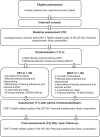Effect of home-based high-intensity interval training using telerehabilitation among coronary heart disease patients
- PMID: 33217814
- PMCID: PMC7676562
- DOI: 10.1097/MD.0000000000023126
Effect of home-based high-intensity interval training using telerehabilitation among coronary heart disease patients
Abstract
Introduction: Cardiovascular diseases are the world's most common causes of morbidity and mortality in the population, including Central Europe. Cardiac rehabilitation (CR) is an effective preventive approach that includes several core components. Physical training is identified as an integral and essential part of CR. Training can positively influence several cardiovascular risk factors in people diagnosed with coronary heart disease and prevent them from clinical events. Our study aims to research the method of high-intensity interval training (HIIT) in a home environment using telerehabilitation. We assume that the HIIT form of telerehabilitation, using a heart rate monitor as a tool for backing up training data, can improve cardiorespiratory fitness and lead to higher peak oxygen uptake than the traditional moderate-intensity continuous training (MICT).
Methods: This study is designed as a monocentral randomized controlled trial at University Hospital Brno in the Czech Republic. After the coronary heart event, the suitable patients will be randomized (1:1 ratio) and separated into 2 groups: the experimental HIIT group and the control MICT group. Both groups undergo a 12-week telerehabilitation with a 1-year follow-up period. Study participants will be telemonitored during physical training in their home environment via a heart rate monitor and a web platform. Once a week, the patients will give their feedback and motivation by a telephone call.The primary outcome observed will be the effect of intervention expressed by changes in cardiorespiratory fitness. Secondary outcomes will be the health-related quality of life, anxiety, training adherence, body composition, safety, and satisfaction.
Discussion: The HIIT is widely researched predominantly in a center-based supervised form. Our study differs from others by the use of telemedicine and smart technologies in home-based settings. Previous home-based cardiac telerehabilitation studies have focused primarily on MICT, which has demonstrated feasibility, and results have shown similar improvements as center-based CR. There is a presumption that HIIT may be superior to MICT. However, it can be complicated to self-dose the method in the home environment. Investigators expect that HIIT research will provide insight into the possibilities of telemedicine feasibility, effect, and limitations of coronary heart disease patients' use at low to moderate cardiovascular risk.
Conflict of interest statement
The authors have no conflicts of interest to disclose.
Figures


Similar articles
-
Short-term and Long-term Feasibility, Safety, and Efficacy of High-Intensity Interval Training in Cardiac Rehabilitation: The FITR Heart Study Randomized Clinical Trial.JAMA Cardiol. 2020 Dec 1;5(12):1382-1389. doi: 10.1001/jamacardio.2020.3511. JAMA Cardiol. 2020. PMID: 32876655 Free PMC article. Clinical Trial.
-
Rationale and design of randomized controlled trial protocol of cardiovascular rehabilitation based on the use of telemedicine technology in the Czech Republic (CR-GPS).Medicine (Baltimore). 2018 Sep;97(37):e12385. doi: 10.1097/MD.0000000000012385. Medicine (Baltimore). 2018. PMID: 30213005 Free PMC article. Clinical Trial.
-
Efficacy, efficiency and safety of a cardiac telerehabilitation programme using wearable sensors in patients with coronary heart disease: the TELEWEAR-CR study protocol.BMJ Open. 2022 Jun 23;12(6):e059945. doi: 10.1136/bmjopen-2021-059945. BMJ Open. 2022. PMID: 35738643 Free PMC article.
-
Effects of high-intensity interval training versus moderate-intensity continuous training on cardiorespiratory and exercise capacity in patients with coronary artery disease: A systematic review and meta-analysis.PLoS One. 2025 Feb 20;20(2):e0314134. doi: 10.1371/journal.pone.0314134. eCollection 2025. PLoS One. 2025. PMID: 39977401 Free PMC article.
-
High-intensity interval training versus moderate-intensity continuous training within cardiac rehabilitation: a systematic review and meta-analysis.Open Access J Sports Med. 2018 Jan 26;9:1-17. doi: 10.2147/OAJSM.S150596. eCollection 2018. Open Access J Sports Med. 2018. PMID: 29416382 Free PMC article. Review.
Cited by
-
Feasibility, safety, and adherence of a remote physical and cognitive exercise protocol for older women.Arq Neuropsiquiatr. 2024 Apr;82(4):1-9. doi: 10.1055/s-0044-1785690. Epub 2024 Apr 23. Arq Neuropsiquiatr. 2024. PMID: 38653483 Free PMC article. Clinical Trial.
-
mHealth in sub-Saharan Africa and Europe: A systematic review comparing the use and availability of mHealth approaches in sub-Saharan Africa and Europe.Digit Health. 2023 Jun 21;9:20552076231180972. doi: 10.1177/20552076231180972. eCollection 2023 Jan-Dec. Digit Health. 2023. PMID: 37377558 Free PMC article. Review.
-
Exploring the emerging trends and hot topics of 5G technology application in wireless medicine: A bibliometric and visualization analysis.Medicine (Baltimore). 2025 Jul 18;104(29):e43310. doi: 10.1097/MD.0000000000043310. Medicine (Baltimore). 2025. PMID: 40696687 Free PMC article.
References
-
- World Health Organization. World health statistics 2015. Global health indicators Part II. World Health Organization, 2015. Available at: http://www.who.int/gho/publications/world_health_statistics/EN_WHS2015_P.... Accessed September 1, 2020.
-
- Heidenreich PA, Trogdon JG, Khavjou OA, et al. Forecasting the future of cardiovascular disease in the United States: a policy statement from the American Heart Association. Circulation 2011;123:933–44. - PubMed
-
- Sandesara PB, Lambert CT, Gordon NF, et al. Cardiac rehabilitation and risk reduction: time to “rebrand and reinvigorate”. J Am Coll Cardiol 2015;65:389–95. - PubMed
-
- American Association of Cardiovascular & Pulmonary Rehabilitation. Guidelines for cardia rehabilitation and secondary prevention programs. Human Kinet 2013;336.
-
- Anderson L, Oldridge N, Thompson DR, et al. Exercise-based cardiac rehabilitation for coronary heart disease cochrane systematic review and meta-analysis. J Am Coll Cardiol 2016;67:1–2. - PubMed
Publication types
MeSH terms
LinkOut - more resources
Full Text Sources
Medical
Miscellaneous

